All in the Family: From Family-Owned Practices and Brands to Product Families, Dentistry is a Family Affair
Children often follow their parents into the profession, the leadership of privately held dental companies is passed down from one generation to the next, and dental products are grouped under the same brand name. However you look at it, dentistry is often a family business. Let’s see why that is the case.
A Family of People
Tim Bizga, DDS, practices general dentistry with his father in Cleveland, Ohio. Before that, he worked as a chairside assistant and a dental lab technician, and those experiences enhanced Bizga Dental, Inc. in many ways. Tim remembers tagging along to the office with his dad, Chester Bizga, DDS, as part of the latter’s attempt to raise a dentist from among his 6 children.
“I joke that Dad started to look at the older 3, and their gifts and talents, and decided that if he was going to get a dentist out of the lot, he needed to resort to brainwashing the most pliable,” Tim jokes. “My memories of the dental office were hanging out with my Dad and raiding the toy chest he had for his kid patients.”
At 16, Tim was no longer pilfering toys but seeking something more valuable. When he asked his father why he had become a dentist, Chester told him about the benefits of owning a business: flexible hours and the ability to provide a comfortable living for one’s family. As a boy in downtown Cleveland, Chester had seen a dentist roll by in a 2-seater convertible with a set of golf clubs in the passenger seat and immediately knew that dentistry was for him.
“My Dad’s vision of being a dentist was [that] he would drive cool cars and get to play golf—and he wanted to golf as much as he could,” Tim says, adding that as the fourth child, he saw the benefits of the hard work his father had put into building the practice and wanted the same benefits for his own wife and kids.
“One of the reasons that families tend to follow suit is that dentistry is a great career.…on the whole, you do very well.”
However, father and son both know that golf and fancy cars are not a given for any dentist. They are the result of sacrifices and putting a great deal of time and energy into taking care of patients. Tim’s older siblings jokingly complain that the younger kids had a far different childhood than theirs. But Tim believes that if children see that dentistry makes their parents happy, they will want to make it their career too.
Nevertheless, he doesn’t plan to push his children, who are still very young, into dentistry, feeling that the profession must be a good fit for any person who pursues it. He would love it if one of them did choose dentistry because it has much to offer, and still will in 15 or 20 years, but he won’t force the issue.
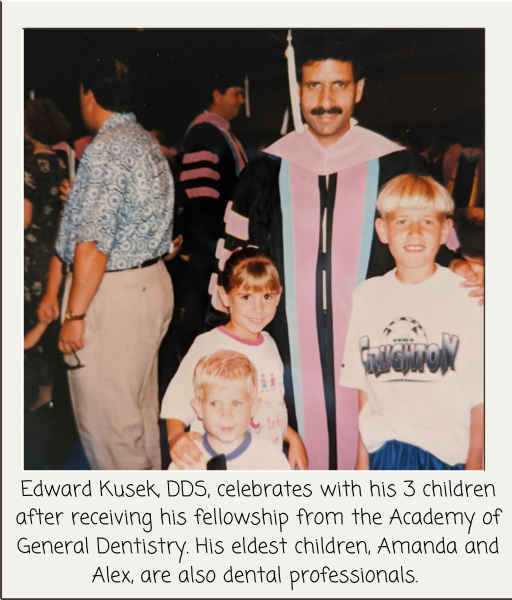
For the Kuseks, dentistry is even more of a family affair. Edward R. Kusek, DDS, and his daughter, Amanda Voegeli, RDH, work at Kusek Family & Implant Dentistry, in Sioux Falls, South Dakota. His son, Alex Kusek, DDS, also worked there but now practices in Mount Pleasant, South Carolina.
The elder Kusek used to take his kids to work when they were little, and Amanda would pretend to do dental work on her brother. Later, pretending became a reality and Alex became one of his sister’s first patients. And because Kusek’s patients knew Voegeli, they accepted her as soon as she began practicing. She’s also “very gentle, and patients like that,” Dr Kusek points out. “She has a better touch than me.” According to Voegeli, that’s down to Dad—it’s “what happens when your dad’s a dentist, and you’re cleaning his teeth,” she says, laughing. “He’s telling you, ‘OK, gentle, gentler,’ every time. So, he trained me to be that way.”
Dr Kusek is also an author and speaker, a clinical instructor for various manufacturers, and an adjunct professor in the dental programs of the University of South Dakota and the University of Nebraska. Voegeli has been editing his papers and helping him with presentations for years. “I was always doing my PowerPoints,” he says, and “she would always see all this bloody stuff,” but it didn’t seem to bother her. “That’s why I am a hygienist,” Voegeli explains. “I don’t mind watching it, but I don’t want to be in it.”
The younger generation also kept the technology up to date. For example, Alex had his father upgrade to faster scanners and encouraged him to add a CBCT unit so that they could assess patient airways. And, encouraged by dad, Voegeli took a laser course.
It can, of course, be tricky to work together. As the liaison between her father and the staff, Voegeli has had many opportunities to hone her diplomatic skills, but the effort has been worth it, the duo agrees because the atmosphere is more fun for everyone. “I enjoy working with my daughter,” Dr Kusek says. “When my son was working with us, I enjoyed that, too.”
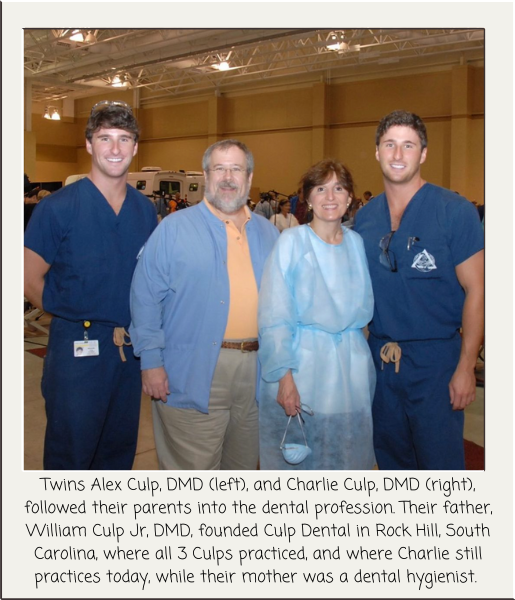
Charlie Culp, DMD, and his twin brother Alex Culp, DMD, also followed in the footsteps of their dentist father and hygienist mother. Alex is an orthodontist with multiple practices, and the brothers have patients in common. Charlie jokes that they used to think that what their parents did all day was spend time with each other—and with teeth. “When we were little, we always thought our parents were the coolest,” he says, adding that they would go to the practice and hang out with them. “Some people don’t appreciate their parents, but we thought they were neat people.”
The brothers never felt pressured to become dentists. Instead, it felt like a natural progression, Charlie says. When Alex decided to leave the family practice (Culp Dental, in Rock Hill, South Carolina) to pursue a specialty, it was hard for him to break the news. But the support was always there, and everyone was happy for Alex.
Like the Bizgas, Charlie believes dentistry often becomes the family profession because it allows practitioners to enjoy a flexible schedule and an excellent quality of life. They can spend more time with loved ones, form stronger emotional bonds, and have open and frank discussions about business. He looks back on his years working with his father and brother as the best of his career. “We always wanted it to be better and more fun, and all of us were in the office for 3 years. Not every day was the best day ever, but some [were]…the best times I’ve had for sure.”
Dawn Rockwell, DMD, and her husband, Alex Rockwell, DMD, are co-owners of Rockwell Dentistry, in Middletown and in Hamilton, New Jersey, and they are excited about their children joining them. Twins Eric and Natasha, are about to graduate from the Kornberg School of Dentistry at Temple University. “We are multigenerational now,” says Dawn Rockwell. “My husband and I have decades of knowledge and experience…to mentor them, and they are trained in the latest digital dentistry techniques, which will add a whole new facet to our practice.”
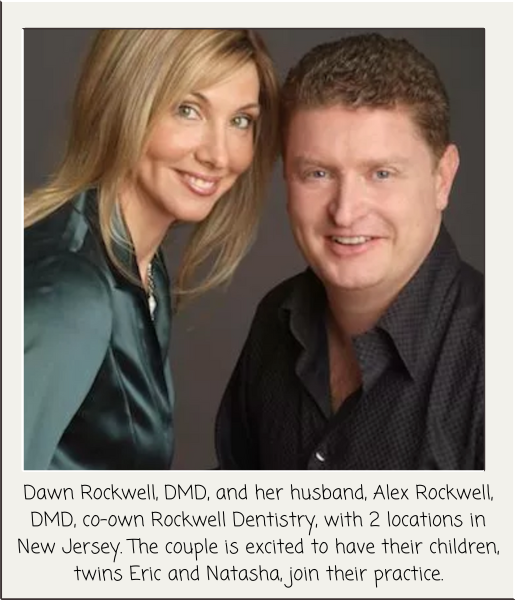
Dr Rockwell says her dad encouraged her entrepreneurial spirit and inspired her to “shoot for the stars.” She chose dentistry because it combines art and science and allows her to be her own boss and to build close professional relationships with patients. Dawn met Alex 30 years ago when, as recent grads, they were associates at the same dental office. Her husband, she explains, followed his mother into dentistry.
Born in Kyiv, Ukraine, where his mother was a dentist, Alex immigrated to the United States in 1976 with his family. It took his mother 2 years to graduate from NYU College of Dentistry and be licensed in New York, and she practiced there until her retirement in 2005. At age 15, Alex began working as a dental assistant in her office during summer vacations, so dentistry was an easy career choice for him.
Rockwell Dentistry is not merely a dental dynasty, but a female dental dynasty. “While there are many mother-daughter dentists, I don’t know of any other grandmother-mother-daughter dentists,” Dawn says proudly. “I think it is a great profession for a woman. It easily allows…your professional and family life [to] coexist.”
In addition, having her children join the practice will guarantee continuity of care, she’s quick to note. “[M]any…patients…[come] to us because their previous dentist retired and they do not like the way…the new office is run.…that won’t happen here,” she says. When patients ask her about retirement, she responds, “No worries…I made 2 clones for you.” In turn, her patients—some of whom are second- and third-generation—can show her children “how interesting and rewarding dentistry is,” she concludes.
Rick Adelstein, DDS, practices with his father, Gerald Adelstein, DDS, at Obermeier, Adelstein, Lempel and Associates, Inc., which has offices in Beechwood and Medina, Ohio. His daughter, Melanie Adelstein, DMD, recently finished her general practice residency and joined the practice. Rick says that his parents actually discouraged him from becoming a dentist, but he always wanted to be one. Even if his father hadn’t been a dentist, he thinks he might have ended up in the field. “Ever since the middle of high school, I was…happy doing things with my hands and love[d] dealing with patients,” he says.
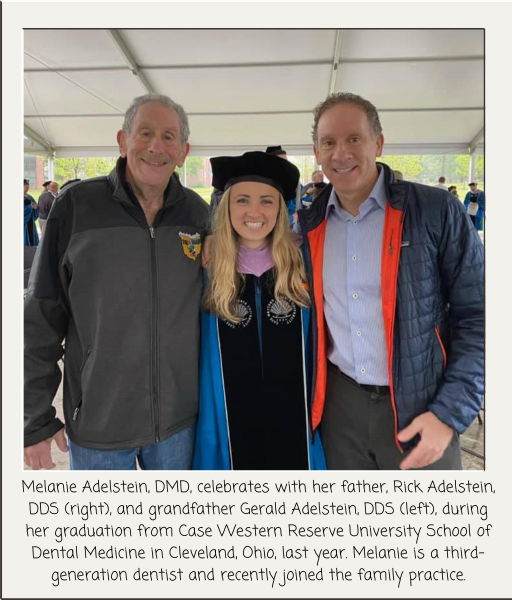
Melanie is no stranger to Obermeier, Adelstein, and Lempel, having worked there in various capacities before joining as a dentist. And she will also benefit from her surname: “When patients get used to dentists they’ve seen for 20 years, and then there’s someone new, they automatically connect the word new to ‘fresh out of school.’ Because [she]…is my daughter, most…patients will accept her…[more easily] than if…[she] wasn’t related,” Rick says.
He looks forward to continuing his father’s tradition of collaborating on decisions about the best course of action. Dr Gerald Adelstein used to ask others, including Rick, for their opinion, and Melanie will have a perspective that her own father wants to hear. For her part, she is eager to use the office equipment she hadn’t been able to touch while in school or residency. Rick also looks forward to the new services, like Botox treatments, his daughter will be offering: “She’s going to take some courses, and once she’s certified, she wants to do [Botox]. So that’s something that we wouldn’t have done,” he says.
Family Companies
Dental manufacturers, distributors, and service providers are also owned and operated by single families. One example is Benco Dental, founded in 1930 by Benjamin Cohen partly to avoid working in a sweatshop, according to his grandson Chuck Cohen, who is a co-managing director with his brother Rick. “I would call it a happy accident that we ended up in dental,” he says, “but I am so glad we did.” Their father, Larry Cohen, is the company’s chief customer advocate.
It was actually another family connection that led Benjamin Cohen to the industry. A distant cousin, Julius Charlestein, had founded Premier Dental Company in 1913, 17 years before Benco was founded. Benjamin started out selling Premier instruments door-to-door before opening his own dental depot in Northeastern Pennsylvania. “The business is still there today, although quite a bit larger than when he started it,” Chuck says.
According to Chuck, there are many benefits to being a family-owned firm. Dentistry is a relationship-oriented field, he points out, and dentists have long-term business relationships with people they know and like, which is why his father, Larry, created a customer-centric environment at Benco and is a fierce client advocate.
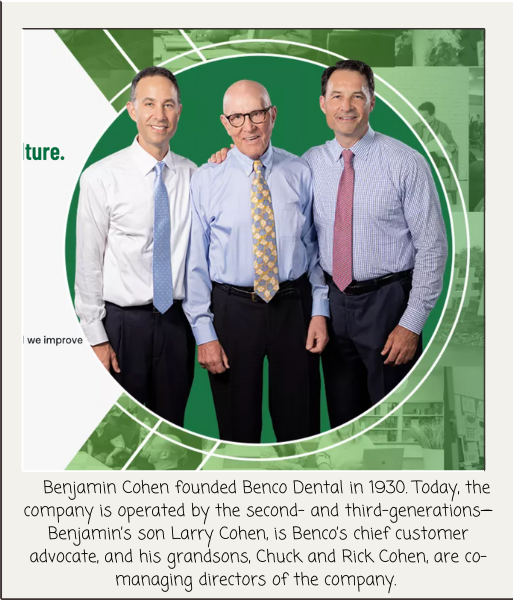
“Customers trust the service they get from a family like ours,” Chuck says. “Being family-owned allows us to be independent; to think in decades, not…quarters; and to have a more trusting relationship with our customers.”
Benco is one of the largest dental-only companies in the world because publicly traded companies tend to be in other verticals, Cohen explains. With 1500 employees who “think, eat, and breathe dental all the time,” Benco is able to focus on dental innovation in a way competitors can’t.
“Our mission statement is, ‘We drive dentistry forward through our innovative solutions and caring family culture,’” Cohen says. “Our goal is to be the most innovative player in the space, drive the industry forward, and…[have] a caring…attitude toward…customers.”
David Lang, president of Lang Dental Manufacturing Company, Inc., is the grandson of Samuel Lang, who founded the company in 1929 and sold materials to dentists in the Chicago area, later distributing them throughout the East Coast. Thanks to David’s father, who had a degree in chemical engineering, the company was able to develop quick-curing acrylics for use in prosthetic dentistry, which are still its focus.
Lang jokes that his mother made him join the firm in junior high to get him out of the house. At first, he filled bottles with acrylic, but after college and a brief stint as a teacher, he rejoined in 1977 and has been at the company ever since. Mostly retired today, he is surrounded by family members. His wife is the company’s quality director, and his children hold leadership positions in quality systems, regulatory, and sales.
No matter their title, however, all of them understand all aspects of the business: “Any of the people in management here could be president [and all] have a good understanding of the regulatory and quality assurance requirements, etc. So, we all wear many hats,” he says.
The company has grown considerably under their careful watch. It became a global company in the 1950s and branched out into other industries, but dental remains its main focus because of the consistent quality of its products and the family’s accessibility, Lang says.
“Every person in management here is intimately involved with the end users,” Lang explains. “We…can communicate with the people who use our products and understand their problems and the things they like…. If you can continue to do that, it helps you keep that mom-and-pop feel, even though you’re a much larger company.”
The family’s involvement with trade associations has put them in touch with other family-run businesses, many of which face challenges similar to those the Langs face. These connections have given Lang Dental access to resources that wouldn’t otherwise have been available to a company of its size.
Nicolle Campion, president of Zirc Dental Products, says the industry is amazing because everyone is passionate about what they do. A manufacturer that uses plastic injection molding, Zirc strives to be efficient by investing in capital equipment and controlling the supply chain so that it can compete with offshore corporations. And its efforts have paid off in recent years.
“It’s been important for us to continue manufacturing in the United States. Everything is made here at our Minnesota facility, so we can see it firsthand,” Campion says. “We want our team to be doing the…quality control and not…someone else.”
Campion also appreciates the stability of the dental industry. As the daughter of James Campion, who started Zirc in 1967, she hopes that the next generation, which is still in school, will take over. And judging by her experience, they might. “Family-run or not, people create great bonds and friendships, and rarely does someone get into the industry and then leave[s],” she says.
Campion has been at Zirc for 22 years, learning different aspects of the business. The more time that passed, the more natural her transition to management became. At first, it was about doing the best she could and watching the company grow, she says.
Later, it was about shaping the company’s direction and working with customers and her team to develop ideas. She plans to use a similar approach with members of the next generation, the oldest of whom is a senior in high school.
“We haven’t quite reached that point of having someone in the third generation who is old enough to know if the family business will be a fit for them, but it would be wonderful if one or all want to join the business someday,” Campion says.
There are many benefits to product offerings when a company is family-run, she says, because there is less red tape to contend with. “When it comes to…product development and…what we’re doing out on the street, we can make a decision quickly,” Campion says. “A lot of the new product ideas we get are from clinicians. So the quicker we can act, the better.”
In addition to its simple but broad product line, Zirc focuses on efficiency and organization. And the gains it makes that way can significantly benefit clients. Zirc also offers consulting services and customizes solutions for dental practices.
“It’s about being organized, yes, but a lot goes behind it. It’s not just fun bins that we have; it’s the whole method behind what you do with the bins and how you use and store them,” Campion explains.
Product Families
Shashikant Singhal, BDS, MS, director of education and professional services at Ivoclar USA, says that product families offer comprehensive solutions. In today’s fast-paced environment, “it is difficult for dental professionals to…[spend] time…finding products and technologies via multiple manufacturers,” Dr Singhal explains. To minimize the lack of compatibility and functionality that can compromise outcomes, manufacturers offer families of products with predictable results.
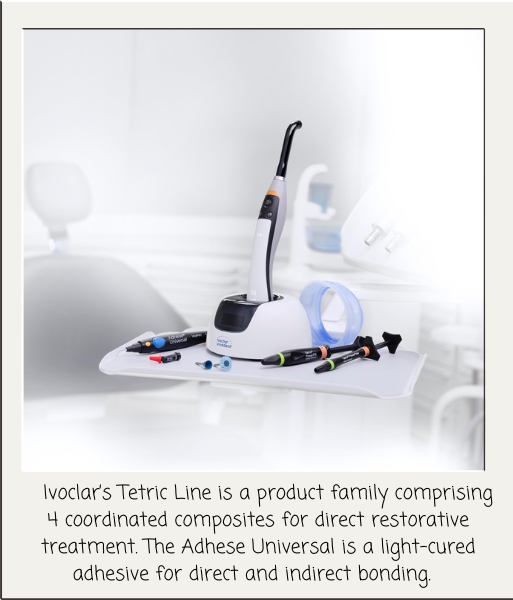
“If a dental professional uses products from one manufacturer, it is easier to provide support and troubleshoot issues. Therefore, a customer can rely on us and consider us a strong partner for their successful, hassle-free business operations,” Dr Singhal says. “Since all the products are tested extensively, we as a manufacturer can predict the outcome…in a clinical situation and guide dental professionals with a recommendation. This helps them provide better service to their patients.”
Benco sources its privately branded products from well-known manufacturers. Chuck Cohen describes the portfolio as a robust selection of the best products available, including the PRO-SYS® toothbrush line and natural extensions® personal protective equipment. Sourcing allows Benco to “offer some fabulous products and technologies at competitive pricing,” he says.
Abir Bou Khouzam, senior marketing manager at Tokuyama Dental America, Inc., believes that adding to a product family increases its usefulness because new components can address other needs. However, these components must have brand recognition for clinicians to trust them, she says. For example, OMNICHROMA’s initial success was partly due to the performance of Tokuyama’s previous composites.
After the launch of OMNICHROMA and OMNICHROMA BLOCKER, the team at Tokuyama introduced OMNICHROMA Flow and Blocker Flow formulations in response to specific clinical needs. By expanding the family, Tokuyama was able to offer other options that have the same predictability dentists have come to expect, Bou Khouzam says.
“The physician is satisfied, and the patient is satisfied,” she says, adding that products that rely on innovation and research must have excellent outcomes to survive and grow. “If OMNICHROMA…hadn’t been a success, the flowable and blocker wouldn’t have gone so well.”
Having more options is always better, but more options also mean more decisions, Bou Khouzam says. Therefore, the marketing team ensures customers are well informed and educated about products, all while building the family brand. Once clinicians are familiar with the products and satisfied with the outcomes, using the family becomes a habit that extends the use of the product and product family to multiple indications, she says.

“This can be a challenge and an opportunity,” Bou Khouzam continues. “Even if a better product comes to market, and this applies to everyone, it will be more challenging to change a clinician’s habits. You must be persistent and have a company and portfolio to back you up. The more [clinicians] see and read about [new] products, the more likely they will consider trying it.”
Russ Perlman, executive director of marketing and communication for North America at VOCO America, Inc., says the goal of product families is to develop trust. Most relationships are based on trust, and when a company develops a family of products, clinicians can be confident that the products will work together as expected.
By introducing a family of products, you’re indicating that they “are meant to work together—and will work together—well,” Perlman explains. “We know, based on science and chemistry, many of these products will work together even when they aren’t from the same brand family, but when we talk about a family of products, we’re talking about compatibility, working together, and trust.”
Perlman says that every practitioner should exercise due diligence and include only products they trust in their armamentarium. But obviously, anything VOCO can do beyond intensive testing and research can be helpful.
For example, products from VOCO’s GrandioSO line can be combined in different restorative procedures. The advantage for clinicians is that they can treat a wider range of problems with a single family of products. VOCO also offers CAD/CAM workflow options with their Grandio blocs.
One of the most significant benefits of product families is their consistency, Perlman explains. Working with products from the same family removes variables that could interfere with the intended outcome, leading to solutions that last.
On the other hand, if “you bring in products [from] outside the family, …there could be a small indication or application changes because of different chemistry or technology,” he says. “That’s where working with a family of products benefits the practice, as it helps to minimize variables.”
The concept of a product family also extends to workflow components. Alyssa Federico, marketing manager at DEXIS Imaging, says that doctors want a one-stop shop, not multiple companies with which to coordinate for workflow. However, by the time they add CBCT, they often already have other digital workflow components in place.
“Therefore, our ORTHOPANTOMOGRAPH® OP 3D CBCT scanner is an open system that…work[s] with just about anything a dental practice might already have or [with] a complete family of products,” Federico explains. “We like to say, ‘We integrate with just about everybody.’”
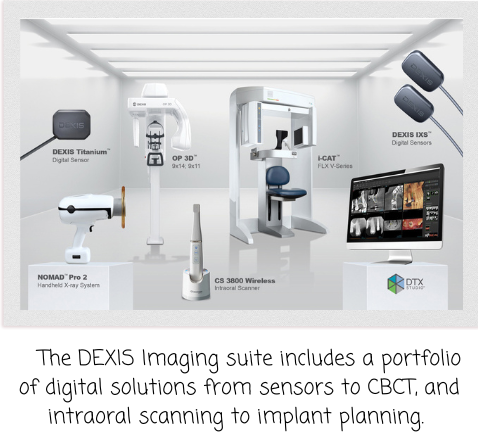
One of the main advantages of having a full suite of products, particularly with DEXIS technology, is the support available, Federico says. She considers investing in a family of products to be like investing in a relationship with the company. DEXIS Imaging takes that relationship seriously, ensuring that clients can reach representatives as quickly as possible when they need help. “You can call and talk to somebody or submit a request, and somebody will get back to you within a few hours, give or take,” she points out.
In addition, buying from a product family enables ease of use with a step-by-step workflow. Even if a dental office isn’t technologically savvy, she says, it’s easy to adapt when you have a workflow that works with you, not against you.
“If you are an orthodontist, [a] specialist, or [a] general dentist, you have a solution that will work for you, whether [you’re] completing your digital puzzle or starting your digital journey. We like to work with the customer on developing a digital roadmap,” Federico says. “This is the new dentistry. It’s amazing to have a one-stop shop for everything with the new dentistry.”
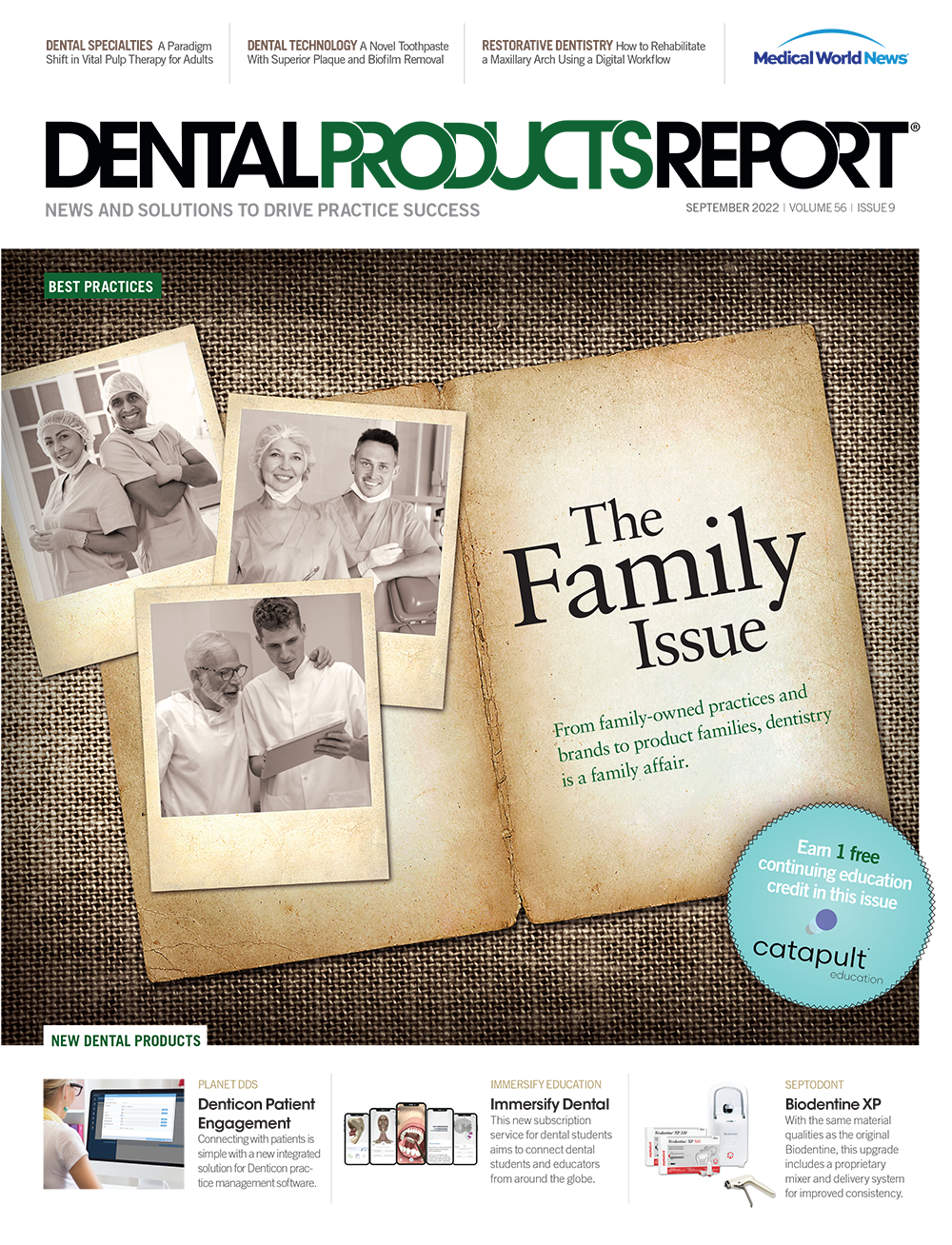
How Dentists Can Help Patients Navigate Unforeseen Dental Care
December 12th 2024Practices must equip patients with treatment information and discuss potential financing options before unexpected dental treatments become too big of an obstacle and to help them avoid the risk of more costly and invasive procedures in the future.